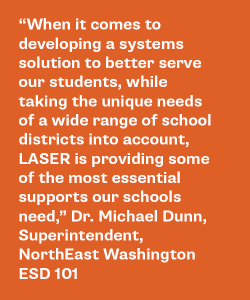STRENGTHENING PRESCHOOL -12TH GRADE STEM EDUCATION
STRENGTHENING PRESCHOOL -12TH GRADE STEM EDUCATION
Overview
 For Washington students to thrive, especially those who have been historically underrepresented in the STEM fields ¬– students of color, students from low-income backgrounds, girls and young women, and rural students – our K-12 systems must do more to provide the necessary educational and career experiences that lead to family-wage jobs and careers.
For Washington students to thrive, especially those who have been historically underrepresented in the STEM fields ¬– students of color, students from low-income backgrounds, girls and young women, and rural students – our K-12 systems must do more to provide the necessary educational and career experiences that lead to family-wage jobs and careers.
We believe that Washington students have a civil and legislative right to graduate STEM literate. STEM literate individuals are critical thinkers and consumers of information, able to use concepts from science, technology, engineering, and mathematics to understand complex problems and to solve them with others. A high quality STEM education in our K-12 systems is essential for all students in our state to develop STEM literacy.
Washington STEM is committed to attending to and supporting all parts of the K-12 continuum through strategic partnerships, advocacy at the state and regional level, and the use of smart, contextualized data that leads to informed decision making.
What We’re Doing
Data Justice
Washington STEM is honored to be partnering with the OSPI’s Office of Native Education (ONE) to deepen our understanding of the issues Indigenous communities face around education equity. One of these issues is how current data collection systems undercounts and underreports tens of thousands of multiethnic or multiracial Native students. This impacts their schools who lose federal funding meant to support Native education. This year, we undertook a series of conversations with Indigenous education advocates to explore how an alternative data collection method, Maximum Representation, can addresses this undercount at the school, district and state levels. Learn more:
- Maximum Representation in Washington State (knowledge paper)
- Maximum Representation at School Districts (knowledge paper)
- Implementing Maximum Representation (one-pager)
Supporting Dual-Credit Enrollment
Dual credit courses provide valuable educational experiences for high-school students and help cultivate a solid foundation for learning and career preparation, all while obtaining college credit and meeting high school graduation requirements. Washington STEM supports equitable dual-credit through both policy and practice efforts. Since 2020 we have participated in the Statewide Dual Credit Taskforce, working with state agencies, institutions of higher education, and K-12 to research and develop policy recommendations that support equitable dual credit enrollment and completion. We also work with educators across the K-12 and high education sectors to curate, analyze and act on available data to improve enrollment and completion of dual credit coursework. Our new High School to Postsecondary Toolkit created in partnership with Eisenhower High School and OSPI, was designed to help practitioners explore the driving questions behind disparities in dual credit participation. The toolkit highlights key opportunities and potential strategies to improve equity in dual credit participation.
Developing data tools
In order for students in Washington to make smart decisions about their future in STEM, they and their adult supporters need to know what jobs will be available in their own backyard, which jobs pay living and family-sustaining wages, and which credentials will help ensure that they are competitive for those jobs. Washington STEM has developed a free interactive data tool, the Labor Market Credential Data Dashboard, to provide that data.
STEM Teaching Workforce…
In our 2022-2024 Strategic Plan, we outline a plan to better understand systemic issues with the STEM teaching workforce. The University of Washington College of Education conducted analysis of recent educator turnover and we shared these findings on Teacher Turnover and Principal Turnover as part of our STEM Teaching Workforce blog series. We will continue to identify ways we can contribute our partnership, direct support, and policy expertise to diversify the STEM teaching workforce and address regional workforce shortages.
K-12 Resources
High School to Postsecondary Toolkit (updated March 2024)
Blog: H2P Collaborative: reimagining postsecondary pathways
Flyer: High School to Postsecondary Collaborative
Case Study: High School to Postsecondary Collaborative
Technical Report: High School to Postsecondary Technical Report
Data tool: Labor Market Data Dashboard
Article: Developing Equitable Dual Credit Experiences
Article: Listening To Student Voice: Improving Dual Credit Programs